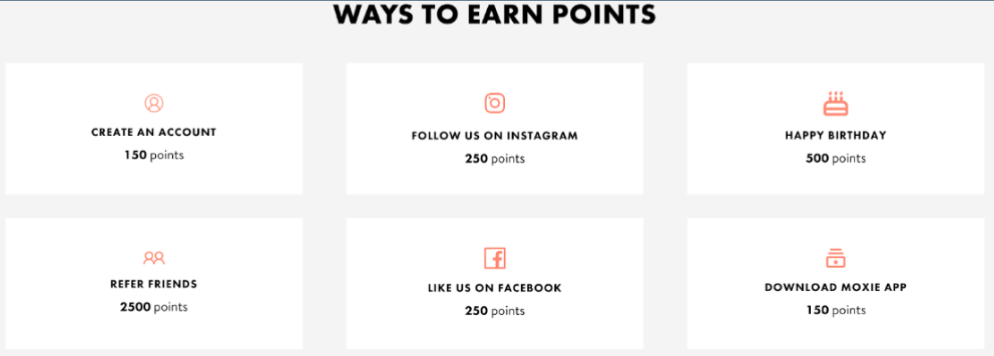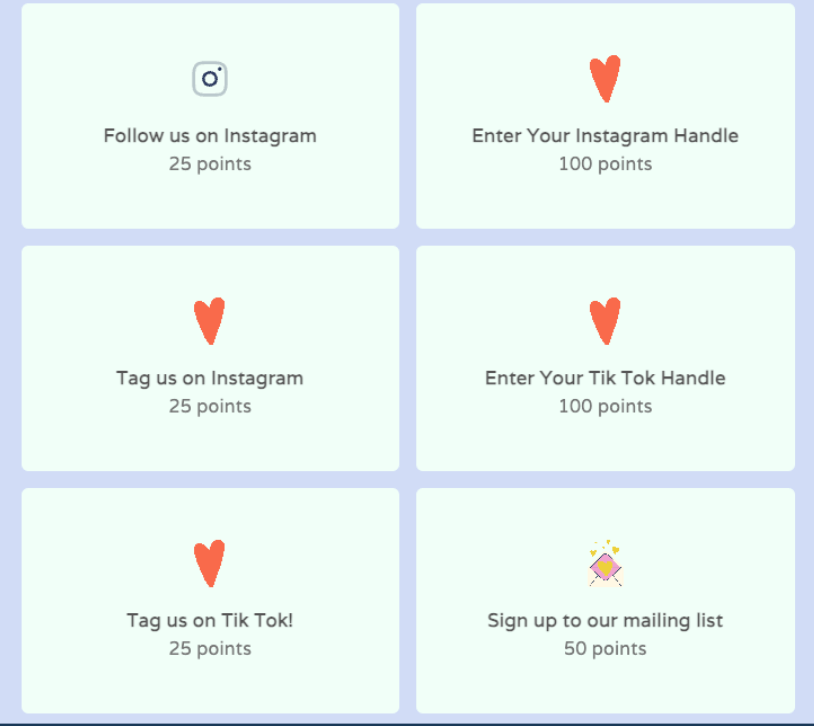Clever marketing can’t make up for a poorly designed loyalty program. But it can light a match under a good one.
So, when you’ve determined your rewards structure, defined your key metrics and assessed your program’s profitability, it’s time to consider promotion.
Referrals, social media, email campaigns: mapping out your loyalty program marketing channels
Unlike bricks-and-mortar stores, ecommerce owners don’t have the luxury of a team of smiling staff waxing lyrical about the loyalty program to customers in-store. So you need to think carefully about the specific channels available to you.
Good examples include:
Referrals
The best way to promote your loyalty program is to get existing members to do it for you.
Step one here is to build a good loyalty program. Nobody’s going to tell their friends about it unless they themselves find it valuable.
But you can help them along by specifically rewarding referrals within the loyalty program itself.
It’s a time-honored tactic:
1. Your customer joins the loyalty program and spends more money with you.
2. They refer three friends to the program to earn more loyalty points.
3. In time, each friend joins the loyalty program and spends more money with you.
4. They each refer three friends to earn more loyalty points.
Waterdrop, for example, integrates referrals into its loyalty program:

But not all referrals are so direct. Many customers will join your loyalty program on the recommendation of a stranger’s online review. So, as with referrals, you can reward online reviews with loyalty points.
Social media
Direct referrals tend to bring in high-value customers, but it’s hard to scale — your customers will only know so many people who would be interested in your loyalty program.
But social media is designed to amplify messages, so it can reach thousands.
Social media marketing is a tough nut to crack. Each platform has its strengths, weaknesses and quirks. Each needs its own strategy. Instagram and Pinterest are often good for showcasing the rewards and experiences customers can gain through your loyalty program. Twitter and Facebook tend to suit quick updates, customer testimonials and time-sensitive promotions.
You can post on your own social media profiles to promote your loyalty program. But the real value tends to come from your happy, loyal customers promoting it on their own profiles.
As with referrals, you can boost social media engagement by incentivizing it through your loyalty program.
MoxieLash Insider includes “Follow us on Instagram” and “Like us on Facebook” as separate reward-earning activities:

Pet brand, Lucy and Co. takes this approach one step further, motivating members to mention them online by awarding additional points to those who tag them on Instagram or TikTok.

Influencers — social media users who have a significant following among your target customers — can be especially powerful amplifiers for your loyalty program. Partnering with them — giving them payment or free products for promotion of your products and your loyalty program— can exponentially boost your visibility.
Some research suggests consumers trust influencer recommendations less than those of other customers — at least in industries such as beauty and cosmetics — because influencers are financially incentivized to promote products. But it’s still a guaranteed way to get your product and/or your program in front of a large number of relevant social media users.
Whichever channels and tactics work best for your social media marketing, your loyalty program should have a strong presence across your profiles. Consider adding direct links to sign up for the loyalty program, showcasing how to earn and redeem points, and highlighting special promotions exclusive to loyalty members.
Email campaigns
Email is a direct and personalized way to tell your existing customers about your loyalty program, and to share updates with existing loyalty program members.
The key to successful email campaigns lies in personalization and segmentation. Start by segmenting your email list based on customer behavior, purchase history, and engagement with your loyalty program. Then, tailor your messages to different groups. For frequent buyers, you might want to highlight exclusive loyalty rewards. You could remind less active customers of their unclaimed loyalty benefits.
A good promotional email for a loyalty program should include things like:
– Testimonials and case studies
– Personalized copy, such as the number of points available to that customer
– A clear call-to-action
For each email you send, test different subject lines, email designs, and content to see what works.
Banners and pop-ups
Carefully placed banners and pop-ups advertising your loyalty program can do wonders for sign-ups.
They should be visible without being intrusive — say, at the top of your homepage. Or across the header of each page.You don’t want to annoy your visitors, but you do want them to notice.
Pop-ups can also be triggered by certain actions, like a visitor spending a specific amount of time on the site or attempting to leave the page.
If you want to get sophisticated, you can personalize banners and pop-ups. If, say, a returning customer has already joined the loyalty program, the banner can display their points balance or inform them about the next reward tier. For new visitors, the banner could highlight the benefits of joining the program.
Mobile apps
According to App Annie, “time spent by US consumers in shopping apps and increasing digital sales had a strong positive correlation of 0.97 between Q1 2014 and Q3 2018”.
In other words, app users are likely to be more engaged and spend more money than web users. This makes sense: on the web, you’re one of millions of potential platforms. When a user downloads your app, you’re likely one of a handful. Combine that with push notifications, and you have much greater access to those customers.
So, if you create a well-designed mobile app through which users can manage their loyalty rewards, you could see higher redemption rates and average order values.
Your mobile app should be seamlessly integrated with your online store. This allows customers to easily earn and redeem loyalty points whether they are shopping through the app or on your website.
Define your key metrics and track your loyalty program marketing — and then adapt
Some marketing channels will bring you more success than others. So you need to track each one’s performance and redirect your efforts towards the best-performing.
Each marketing channel has its own set of important metrics.
1. Referrals: For referral programs, track the number of referrals made, the conversion rate of these referrals, and the subsequent engagement of referred customers with your loyalty program.
2. Email Campaigns: For email marketing, key metrics include open rates, click-through rates (CTRs), and the conversion rate of recipients joining your loyalty program. Segmenting these metrics based on different customer groups can provide deeper insights into which segments are most responsive to your emails.
3. Social Media: On social media platforms, engagement rates (likes, comments, shares), follower growth, and click-throughs to your loyalty program sign-up page are essential metrics. Tracking the performance of different types of content (e.g., posts, stories, videos) can help you understand what resonates best with your audience.
4. Website Banners and Pop-ups: Monitor click-through rates, the percentage of banner/pop-up views that result in loyalty program sign-ups, and bounce rates (to make sure your pop-ups aren’t harming the user experience).
5. Mobile Apps: Key metrics for mobile apps include app downloads, active users, engagement with loyalty program features within the app, and the rate of loyalty point redemption through the app.
These metrics are your concrete, quantitative baseline. But qualitative data gives nuance and context.
Surveys, customer interviews, and reviews can offer insights into customer perceptions of your loyalty program and its marketing, and are easy to incenvitize with loyalty points
Start with what you have — segment your customers and reach out to the most loyal first
There are lots of loyalty program marketing channels in which you can invest your time and budget. So you need to prioritize.
To do this, analyze your customers, segment them, and prioritize the most loyal and high-spending.
Customer segmentation involves dividing your customer base into groups based on certain characteristics, such as purchasing behavior, order value, frequency of purchases, and engagement with your brand.
Consider:
1. High-value customers: These are customers who make frequent purchases or have high order values. They are likely already loyal and may be more receptive to joining and actively participating in a loyalty program.
2. Frequent buyers: Customers who purchase regularly, even if their order value isn’t high, show a consistent commitment to your brand and are prime candidates for loyalty program engagement.
3. New customers: Recently acquired customers can be nurtured into loyal customers through early introduction to your loyalty program.
4. Lapsed customers: Customers who haven’t made a purchase in a while can be re-engaged with incentives through the loyalty program.
Once you’ve segmented your customers, tailor your communication to each group. High-value customers might appreciate exclusive rewards or early access to new products, while frequent buyers could be motivated by points or tier-based rewards. For new customers, try a sign-up bonus. Re-engagement campaigns work well for lapsed customers.
Some of your segments might respond better to email marketing, while others are more engaged on social media or through mobile app notifications. Use historical data to figure out the best channel(s) for each segment.
Start with the most profitable segments, and be ready to adjust and adapt based on the data you’re seeing. This not only maximizes the return on investment but also helps in creating brand ambassadors who can spread the word about your loyalty program through word-of-mouth and referrals.
Ready to use loyalty marketing to your advantage?
Marketing is important, but it’s the design of your loyalty program that will ultimately make it a success.
And for many smaller ecommerce businesses, this is the biggest challenge: implementation. How do you set up, optimize and analyze your loyalty program without significant investment of both time and money?
With this, LoyaltyLion can help. When you’re ready to get started, book a demo.




